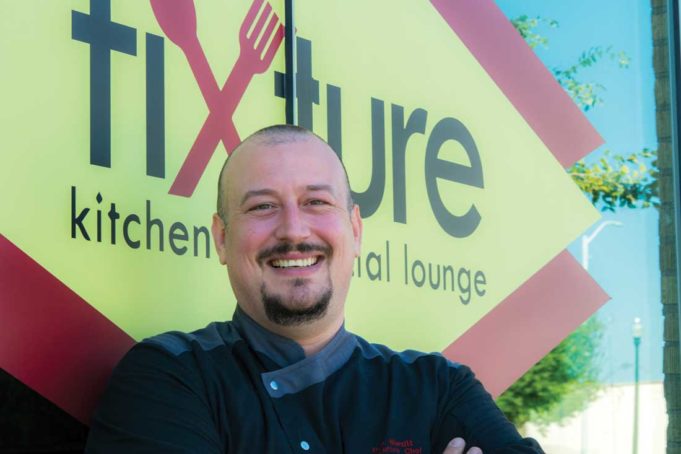Can you take the “cow” out of Cowtown? Probably not completely. But Fort Worth’s Blue Zones initiative is aiming to change how restaurants market lighter, healthier eating choices. And a recent trial run in a few local restaurants showed that restaurants’ bottom lines were not negatively affected when servers recommended plant-based entrées over the steak and potatoes. In fact, some bottom lines improved.
The Blue Zones movement began with 2009’s The Blue Zones: Lessons for Living Longer from the People Who’ve Lived the Longest. As a writer for National Geographic, author Dan Buettner spent eight years traveling to different cities and countries where individuals’ personal habits made a measurable difference in their health, rates of disease, and longevity. Predictably, healthy eating and daily activity are high on the list of factors that improve health, along with intangibles like spirituality and a sense of belonging.
Blue Zones is a public-private partnership sponsored by Healthways, the wellness company that owns several brands, including the Ornish Lifestyle medicine program for cardiac rehabilitation and Silver Sneakers. Local partners here include hospitals, the City of Fort Worth, and employers like Burlington Northern Santa Fe and Lockheed Martin. Although Fort Worth has participated in the project for only about two years, it’s the largest demonstration site of the eight metropolitan areas across the nation. Fort Worth’s team was recognized at the Blue Zones Project National Summit in November with an award for the Server Incentive Program, in which servers at three participating restaurants were motivated to highlight lighter, healthier menu options.
It’s probably no surprise that reducing consumption of red meat, saturated fat, and cheap carbs figure high on the list of Blue Zones’ recommendations. But we live in Fort Worth, where we want our beef and our endless baskets of chips and salsa. How do you convince servers to recommend $15 worth of vegetables or plant-based proteins over a $30 steak entrée? Common sense suggests that servers may not lead with the less expensive Blue Zone-friendly options because the total cost of the meal affects the amount of the server’s tip. Additionally, servers do certain things by rote, like bringing out a basket of chips and salsa or a loaf of bread with butter along with the initial round of beverages. While these restaurant giveaways are tasty (and we’ve come to expect them), they actually can affect the bottom line cost of the meal. Diners who fill up on the cheap “free” carbs may order less.
Project Retail Food Coordinator Clay Sexauer said the Server Incentive Program was a success in helping both servers and restaurant owners see the value of the project. Over the summer, Sexauer and staff trained local servers to promote specially designated Blue Zones-friendly menu items. The menus also got a facelift highlighting those offerings. Servers were incentivized with gift cards as prizes for increasing the sales of items that met the criteria. After the month of promotion, restaurant owners found that their overall food sales didn’t decrease at all.
According to Sexauer’s data, Fixture Kitchen and Social Lounge saw its price-per-person average increase by 13 percent when servers started suggesting Blue Zones-friendly menu items, and Fixture’s overall tab for food sales also increased 13 percent. The meat-and-carb-heavy Los Vaqueros Restaurant saw its price-per-person average go up almost 25 percent. In addition to the gift card incentives, servers saw increases in their bottom lines as well.
To receive Blue Zones designation, local restaurants are given a menu of best practice actions, which include offering half-size portions, providing at least one entrée (not just salad) that meets the healthy eating guidelines, sourcing locally/regionally grown fruits and veggies, removing salt shakers from tables, going non-smoking, and offering 100-calorie “nice bite” dessert items. Restaurants have to accomplish only about two-thirds of these actions to qualify.
A typical Blue Zones-friendly entrée incorporates vegetables, a plant-based protein, or sheep’s or goat’s milk cheese. The meal can include an egg and whole grain bread or corn tortillas. Buy-in from and training of servers in the presentation of the special items is critically important, according to Sexauer, because ultimately, the person taking the order is often in control of whether or not a consumer notices a dish and how attractively the food is presented.
The Blue Zones-approved restaurant list is packed with restaurants you’d expect, like Mediterranean stalwarts (Byblos and Z’s Café) and Asian joints (HoYa Korean Kitchen) where the respective cultures are already focused on fresh, plant-based diets. Lanny Lancarte’s clean-eating Righteous Foods made the list along with, predictably, Fort Worth’s only vegan restaurant, Spiral Diner and Bakery. But the list also includes cafeterias for major employers, like the Camelot Court of Cook Children’s Medical Center, and Westside eatery Buffalo West.
Chris Pikarski, Buffalo West managing partner, said he was skeptical when Sexauer and the Blue Zones Project staff came calling, but that the data Sexauer showed him was compelling.
“I thought, ‘OK, here we go,’ ” Pikarski said, rolling his eyes. “But 20 minutes into the conversation, I thought, ‘Hey, we already have the menu items here.’ ”
The steak-heavy menu at Buffalo West also contains a salad bar, vegetable soup, and vegetable sides to sub for a baked potato or fries. Pikarski said his staff simply prioritizes offering asparagus or broccoli first as meal sides rather than potatoes, and the restaurant added a vegetable sandwich with feta cheese, a grilled portabello mushroom entrée, and veggie tacos on corn tortillas. The menu now includes a $5 100-calorie Nice Bite bread pudding, which is about one-third the size of the $8 regular portion.
Pikarski is also cognizant that diners are yearning for lower-fat and lower-calorie choices and that if one person in a group is vegetarian, he or she usually dictates the decision about where to eat. If there’s no plant-based entrée that’s appealing, then that party’s not coming to his restaurant.
Natalie Meyer, Terra Mediterranean Grill manager, said that although the Mediterranean chain seems like a perfect fit for the Blue Zones Project, the Fort Worth restaurant started participating in the program only this past summer. Some of the plant-based items at Terra do not qualify for Blue Zones-friendly designation –– Terra’s hummus contains Greek yogurt, and while that may make the dip creamy and tasty, the small amount of dairy disqualifies it. Currently, Terra has a separate Blue Zones-friendly menu with a mezza plate of feta cheese and olives and a veggie moussaka. The restaurant also added small-salad options for $6 instead of the $8 regular salad. During the incentive program, Meyer said her servers were incentivized to promote adding a salad or vegetable soup to the dinner service, which, unlike lunch, is not a buffet.
“Increasing the amount of side salads didn’t compromise either the check price or the server’s tip,” she said.
Meyer also acknowledged that she has relatively little employee turnover, so promoting Blue Zones-friendly items and training her staff aren’t burdensome.
Fixture chef/owner Ben Merritt said that it took only a couple of tweaks to his existing menu to earn the Blue Zones-friendly designation. Merritt added a bigger salad and took the salt off the tables. He said that the Blue Zones menu “gives everybody a healthy option, and it does well for us.”
Merritt said training his servers was relatively painless.
“Luckily, I have servers who have healthy lifestyles,” he said.
And he saw an uptick in beverage and appetizer sales when his servers focused on the less-expensive Blue Zones-friendly menu items.
“People plan on spending a certain amount on what they eat,” he said. “And they’ll spend that amount whether it’s one entrée or several shared items and a glass of wine.”
But not all restaurateurs in Fort Worth are convinced. Chef Jon Bonnell owns three restaurants and said that while he definitely supports the project and the idea of healthier eating, he wasn’t sold.
“It’s slightly outside of our parameters,” he said. “At the fine-dining level, [Blue Zones’ rules] are just difficult to accommodate.”
Bonnell touts the benefits of wild game as some of the leanest animal protein available, and many of the fish entrées coming out of his Waters Bonnell’s Coastal Cuisine are low in fat and can be served without added fat or carbs. But, he believes, Fort Worth’s Blue Zones staff doesn’t have the flexibility to tailor options to allow anything but the national initiative’s plant-based protein recommendations on the menu.
Reata Restaurant President Mike Micallef said that while some of his menu items and many of the restaurant’s practices meet the Blue Zones requirements, he hasn’t jumped on the bandwagon either.
“I have a vegetable plate now, and it’s the lowest seller on my menu,” Micallef said.
Micallef also objects to the fact that the Blue Zones Project has not targeted larger chains. A diner might visit Reata once or twice a year, as opposed to Chili’s, McDonalds, or Chick-Fil-A a couple of times a week.
Finally, Micallef takes issue with simply taking aim at restaurants as the source of healthy or unhealthy choices. Exercise is also touted as part of the Blue Zones Project.
“But [Blue Zones] aren’t targeting Nieman Marcus for selling Manolo Blahniks instead of tennis shoes,” he said.
Tongue in cheek as that might be, it’s true that nobody’s incentivizing any stores to sell sneakers instead of stilettos.
Matt Dufrene, Blue Zones Project Fort Worth vice president, acknowledges Micallef’s comments but said that the organization is moving as quickly as it can.
The Blue Zones Project, he said, is “working with owners and managers of restaurants across the city, including individual establishments and chains.”
Some local outposts of national chains are already onboard, Dufrene said, including Zoë’s Kitchen, Planet Sub, Snappy Salads, and Salata.
“We will continue to seek out new partners in all areas of the restaurant industry,” he added.
In addition to the challenge of arguing that Blue Zones menu items won’t lose the restaurants and servers any money, there’s the issue of momentum and the continuous training requirements for new staff as turnover occurs. Terra’s Meyer said that Blue Zones Project training has become part of the organization’s existing manual. But in restaurants with higher server turnover, it may take a lot more than a single dose of education.
Dufrene said that thanks to the initial success, the program (with additional incentives, including personal fitness trackers and restaurant gift cards) will be implemented this year, now with four new restaurants.












